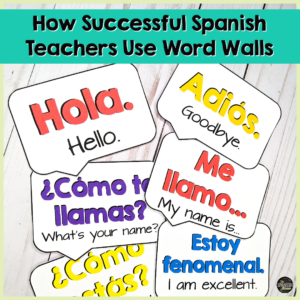Have you tried a running dictations activity in your Spanish class but are ready to take it to the next level because it is SUCH a great way to expose students to the target language and give them some fun Spanish review? Excited to mix up this Spanish activity and really see what Spanish your students are able to produce? But wait, wouldn’t you love that incredible activity to be super low prep to take your lesson plans to the next level?! Then you won’t want to miss the best part: this twist on running dictations – one of my favorite activities for Spanish class!! Having some new ways to present a running dictations activity will keep your students engaged & having fun.
I first herd about running dictations from the amazing Jason Fritze at the CI Midwest conference. And then learned about adding images from Sarah Breckley. My students love it so much that we use it right in the first two weeks of school (learn how here). I think it is such a fun and valuable activity, that I want to share TWO different ways to use it in your Spanish classroom. Read on in this blog post to find out how to keep running dictations fresh and fun.
How to Prep (It’s minimal)
Before class starts, in the hallway or on one side of the room the Spanish teacher will post 6-ish pictures that you feel your students can describe in Spanish. When your students come to class, arrange them in teams of 3-4 students and assign each student one of the different roles: Runner, writer, helper.
How to play – Option one:
Tell your students to take out 1 piece of paper per group and to dive their paper into 6 boxes (or however many pictures you have in the hallway). If you’re looking to be as organized as possible and save classtime, you can print the running dictations slips with the 6 boxes before class starts to quickly pass out to your students.
One student from each group runs to one of the pictures, analyzes it, and runs back to the team to describe it in Spanish. Remind them that using the high frequency verbs like the Super 7 are a great way to describe the images. Don’t stress if their verb forms aren’t perfect. The key is if they are able to effectively communicate. Group members listen carefully, making this a quick listening activity! And then the drawer then makes a drawing based on the description in Spanish that their teammate gave them. Make sure they record their answers in the correct order! There will be a lot of movement in your classroom, which the students love but can also be a little overwhelming for teachers the first time you play!
Tailor your expectations to your student’s level of Spanish. Novice learners can make lists where as upper level students can write in sentences and paragraphs. So, for example, if you posted a picture of a family, your novice students might just write “familia” or “la familia es pequeña.” Where as your upper level students might write something like “La familia es de Colombia y prefieren comer arepas.” Tell them they can be creative (like, make up the backstory) or they have to tie it to information you’ve been learning in class. The beauty in this twist to the game is that there are no exact correct answers. Plus, this is an easy way to add in some culture too!

Option two:
Prior to class, write out 6 sentences that correspond to the pictures in the hallway. (For example “El padre tiene pelo negro.) Make 1 copy of this for each group. Assign a letter to each of the pictures. For example, the picture above could be “A.”
One student from each group runs to one of the pictures, analyzes it, and runs back to the team to describe it in Spanish. They then have to match what they’re hearing with the sentence they see on the paper and write down the correct letter.
Easy topics to turn into a running dictation activity with pictures:
Running dictations are a great review for any of these topics because they get to use so much Spanish in a short amount of time!
- Physical descriptions
- Family
- House
- Where things are located in the classroom
- Sports
- Cultural items/symbols
Quick Extension Activity for Running Dictations:
Once your students have correctly identified all the pictures and the activity is over, use those same images to create a classroom discussion. Write 2-3 discussion questions for each of the images using high frequency verbs. I recommend discussion questions that relate to the students and their opinions or preferences. For example, “¿Te gusta…” and “¿Prefieres…?”
Running dictation activities are such a great activity to review new vocabulary and practice Spanish listening skills. World language teachers and students love them! Have you tried running dictations in your class? Ready to start with some zero prep activities (seriously, everything included!). Click here to see my favorite Spanish running dictations activities that are packed with culture!




No Comments